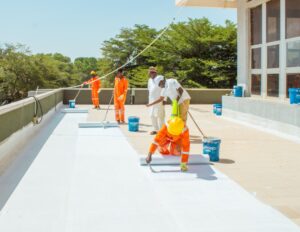Introduction
When starting a painting project, one of the first questions that arises is, “How much paint do I really need?” Estimating the right amount is essential—not just to avoid unnecessary trips to the store but also to save time, money, and effort.
Overbuying leaves you with leftover paint that may go to waste, while underestimating means you risk running out mid-project. This guide will help you determine how much paint you need with precision, ensuring a smooth and efficient painting experience.
Understanding Paint Coverage Basics
What is Paint Coverage?
Paint coverage refers to the area a single gallon of paint can cover. Most paints on the market indicate an average coverage of 350–400 square feet per gallon under ideal conditions.
However, actual coverage can vary due to several factors such as surface type, paint quality, and application method.
Factors That Influence Paint Coverage
1. Surface Texture
- Smooth Surfaces: Require less paint as they provide minimal resistance.
- Textured Surfaces: Consume more paint as the texture creates more surface area to cover (e.g., stucco or popcorn ceilings).
2. Surface Porosity
- Unpainted or Bare Surfaces: Highly porous surfaces like drywall, plaster, or raw wood absorb more paint, requiring additional coats or primer.
- Previously Painted Surfaces: These are less absorbent and usually require less paint.
3. Color Changes
- Light to Dark: Darker shades may need more coats to achieve full opacity, depending on the paint’s pigmentation and quality.
- Dark to Light: Lighter colors might require multiple coats to completely cover a dark base.
4. Type of Paint
- Flat/Matte Paint: Absorbs more and covers less area compared to semi-gloss or gloss finishes.
- High-Quality Paints: Typically offer better coverage, requiring fewer coats than cheaper alternatives.
5. Number of Coats
- A single coat may suffice for touch-ups or minor changes. However, most projects require at least two coats for even, durable coverage.
How to Calculate Paint Needs
Step 1: Measure the Surface Area
- Walls:
- Measure the height and width of each wall.
- Multiply the height by the width to calculate the square footage.
- Add the square footage of all walls together.
- Ceilings:
- Measure the length and width of the ceiling.
- Multiply these dimensions to get the square footage.
- Doors and Windows:
- Subtract the areas of doors (approximately 20 square feet each) and windows (15 square feet each) from the total.
Step 2: Factor in Additional Needs
- Add an extra 10–15% for touch-ups or errors.
- Increase the estimate for textured or porous surfaces.
Step 3: Divide by Paint Coverage
- Divide the total square footage by the coverage per gallon indicated on the paint can (usually 350–400 square feet).
- Round up to ensure you have enough paint.
Example Calculation
Imagine you’re painting a 12×10-foot room with an 8-foot ceiling:
- Walls:
- Wall 1: 12 ft x 8 ft = 96 sq. ft.
- Wall 2: 10 ft x 8 ft = 80 sq. ft.
- Total for 4 walls = 96 + 96 + 80 + 80 = 352 sq. ft.
- Ceiling:
- 12 ft x 10 ft = 120 sq. ft.
- Subtract Doors and Windows:
- One door: 20 sq. ft.
- Two windows: 15 sq. ft. x 2 = 30 sq. ft.
- Total to subtract = 50 sq. ft.
- Final Surface Area:
- 352 sq. ft. (walls) + 120 sq. ft. (ceiling) – 50 sq. ft. = 422 sq. ft.
- Paint Required:
- 422 sq. ft. ÷ 350 sq. ft. per gallon = 1.2 gallons.
- Round up to 2 gallons for two coats.
Tips for Accurate Estimation
Use Online Paint Calculators
Many paint brands offer online calculators where you input your room dimensions for a quick estimate.
Consider Primer
Priming surfaces can improve paint coverage, especially when transitioning between drastically different colors or painting bare surfaces.
Account for Color and Finish
- Dark Colors: Often require more paint for full coverage.
- High-Gloss Finishes: Reflect light and may require multiple coats to hide imperfections.
Always Buy Extra
- Purchase an additional quart or gallon for future touch-ups.
- Most retailers accept unopened returns, so buying slightly more is better than running short.
Pro Tips for Maximizing Paint Coverage
1. Prepare the Surface
- Clean walls to remove dust, grease, or residue.
- Sand rough areas and patch holes to create a smooth base.
2. Use Quality Tools
- High-quality brushes and rollers distribute paint more evenly, reducing waste.
3. Apply Paint Evenly
- Use consistent strokes and avoid overloading your brush or roller.
- Apply thin layers rather than thick ones for better coverage and durability.
4. Follow Drying Times
- Allow each coat to dry fully before applying the next to prevent streaking or uneven coverage.
Common Mistakes to Avoid
1. Skipping Primer
Neglecting primer can lead to uneven absorption and wasted paint, especially on porous surfaces.
2. Underestimating Needs
Always calculate generously to avoid running out of paint mid-project.
3. Ignoring Lighting
Test paint samples under your room’s lighting conditions to avoid surprises.
Conclusion
Estimating how much paint you need doesn’t have to be complicated. Just consider factors like surface area, texture, and color, then, you can calculate your needs with precision.
Proper preparation, the right tools, and high-quality paint will ensure a professional finish that lasts for years. So, before you pick up that roller, take the time to plan—it will save you time, money, and effort in the long run.





